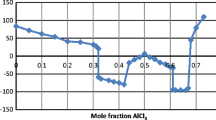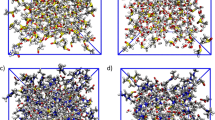Abstract
The aqueous solubility of a diatomic molecule as a function of its size & electronegativity difference is investigated. The electronegativity of a diatomic molecule will be calculated using five different electronegativity scales, namely, Pauling [1], Allred-Rochow [2], Mulliken [3, 4], Parr-Yang [5], and Sanderson [6, 7]. It is hypothesized here that at a given pH, temperature, and pressure, the solubility of a diatomic molecule in water will be a function of its polar character; in particular, electronegativity difference and of its molecular size. Different forms of the solubility function were tested; it was found that the solubility model, given by Eq. 3, which is based on different electronegativity scales and the molecular volume, adequately describes the aqueous solubility of alkali halides. The aqueous solubility of alkali halides exhibits maximum at the condition of high electronegativity difference and large molecular volume. On the other hand, the minimum solubility region is observed at very low molecular volume and medium to slightly high values of electronegativity difference. The minimum solubility is also observed at low value of electronegativity difference and high molecular volume. Finally, the general trend of solubility of alkali halides, based on the proposed model (Eq. 3) could be explained in terms of the trade-off between electrostatic interactions (solid lattice side) and the entropic effects (water side).



Similar content being viewed by others
References
Pauling L (1960) The nature of the chemical bond, 3rd edn. Cornell University Press, Ithaca
Allred AL, Rochow EG (1958) A scale of electronegativity based on electrostatic force. J Inorg Nucl Chem 5:264–268. doi:10.1016/0022-1902(58)80003-2
Mulliken RS (1934) A new electroaffinity scale; together with data on valence states and on valence ionization potentials and electron affinities. J Chem Phys 2:782–793. doi:10.1063/1.1749394
Mulliken RS (1935) Electronic structures of molecules XI. Electroaffinity, molecular orbitals and dipole moments. J Chem Phys 3:573–585. doi:10.1063/1.1749731
Parr RG, Yang W (1989) Density-functional theory of atoms and molecules. Oxford University Press, New York
Sanderson RT (1988) Principles of electronegativity. Part I. J Chem Ed 65:112–118
Sanderson RT (1988) Principles of electronegativity. Part II. J Chem Ed 65:227–231
Noorizadeh S, Shakerzadeh E (2009) Bond dissociation energies from a new electronegativity scale. J Mol Struct 920:110–113. doi:10.1016/j.molstruc.2008.10.026
Smith DW (2007) A new approach to the relationship between bond energy and electronegativity. Polyhedron 26:519–523. doi:10.1016/j.poly.2006.09.013
Politzer P, Murray JS (2006) A link between the ionization energy ratios of an atom and its electronegativity and hardness. Chem Phys Lett 431:195–198. doi:10.1016/j.cplett.2006.09.062
Shackelford JF, Alexander W (2003) Materials science and engineering handbook, 3rd edn. CRC Press, New York, p. 44/1928 PDF softcopy
Lide DR (2004) Handbook of chemistry & physics, 84th edn. CRC Press, LLC, pp 4–37
Author information
Authors and Affiliations
Corresponding author
Rights and permissions
About this article
Cite this article
Al-Malah, K.I. Aqueous solubility of a diatomic molecule as a function of its size & electronegativity difference. J Mol Model 17, 325–331 (2011). https://doi.org/10.1007/s00894-010-0729-1
Received:
Accepted:
Published:
Issue Date:
DOI: https://doi.org/10.1007/s00894-010-0729-1




